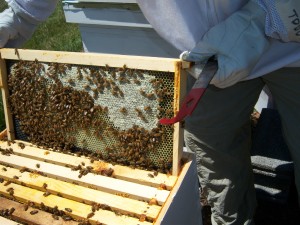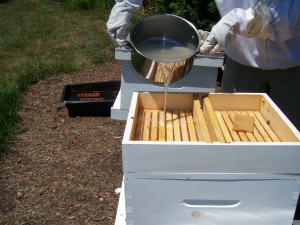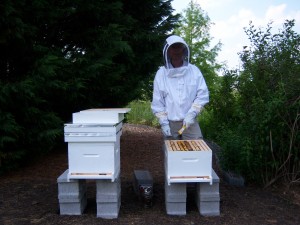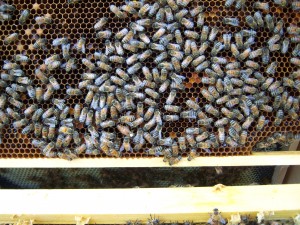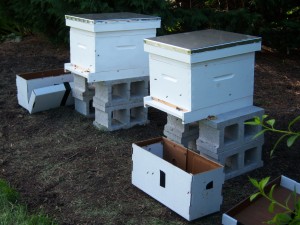Honeybees

Bees are doing well
0I looked in on the bees today. It was ideal weather – hot and sunny – and the bees were quite busy doing what they do. As usual, Joni was taking pictures for me and toward the end one bee was buzzing around her a bit too closely for her comfort and she started doing the bee dance – waving frantically and hopping around yelping. The end result was a minor sting. She never found a stinger and doesn’t remember actually feeling the sting, but after a few minutes found a spot on her arm where she was stung. Despite taking one for the team, she got some nice shots of the bi-weekly examination.
I have been trying to feed the bees every week, but only opening the inner cover to examine the frames every other week. I always seem to start with the B hive (Boston) which is the more developed hive and then when I get to the A hive (Anaheim) I am a bit disappointed. So next time, I want to remember to open Anaheim first.
Boston looked great. Lots of bees on the top of all the frames and all frames with at least some development. This was good progress since week six. The two outer frames still have lots of comb to go, but it got me wondering when or if I should put on another box. I need to read up on mid summer maintenance. Do keepers add boxes or supers this late in the season? Do I need to worry about a swarm?
Anaheim is behind, but only about two to four weeks. Hopefully both hives will be strong by the fall and will overwinter. I didn’t want to take the time to find the queens, as both hives looked like they were maintaining good brood frames. Also each hive still has a frame of honey although there were bees on them and they weren’t full. I suppose that the bees have been using some of the honey. I hope this is normal but I don’t really know.
Both feeder boxes were empty. This has been working nicely because when I fill them back up with my 1 : 1.5 sugar mix (1 cup of sugar to 1.5 cups of water), I flush out a few small hive beetles which I can then get rid of usually bysmashing them with my hive tool. I am assuming that just a few SHBs is normal and not something to worry about. I keep saying that I am going to make some traps, but I haven’t done it yet. I haven’t seen any sign of damage to comb or brood. Joni got a short video which I will post.
Bee patient
0The honeybees seem healthy, but whatever it is that they are suppose to be doing, they are doing it slowly. I keep waiting for my blank frames to fill up with brood and honey, but it is just not happening. Hive A (I think I will call it Anaheim) has always been a lot less active than hive B (let’s call it Boston). They both came as nucleus hives (nucs) from the same beekeeper, so I don’t know why one would be so different from the other. I have read that others have observed the same thing. Nobody seems to know why. After two or three weeks I began to notice that Anaheim had its moments. Around midday or early afternoon on some days, Anaheim seemed a little busier than Boston.
Last weekend when I looked into the hive for only the second time, I found that Boston had filled about one and a half sides of a new frame, but there was very little development anywhere else. Anaheim has only a little comb starting on one new frame.
My nucs came as five frames: one full frame of honey, two frames of mostly empty comb and two frames of brood and bees. I don’t know how many bees I got, but my guess is about a pound or even less which might be about 3,000 bees. Of course, there is also brood in many stages which means that new bees are in the pipeline. The other main option for starting a hive is to get a package of adult bees usually either three or four pounds which means in the 10,000 to 15,000 bee range. But these installations have no brood and the queen has to acclimate herself to her new home and start laying eggs which take around three weeks to hatch.
I assumed that my small village of two or three thousand bees would soon be 10,000 and the queen would quickly fill up the drawn comb with more brood and start drawing comb on my five brand new frames that fill out the 10-frame hive box.
I’m sure I was being a bit impatient, but now after a month, I feel like I might have doubled the population in each hive, but still not made much progress toward filling up the hive boxes.
I hadn’t thought too much about the timing, but apparently the biggest growth spurt of the year comes in the early spring, perhaps mid March through mid May here in Maryland. That is when there is lots of flowering going on and most of the bee populations grow to swarming proportions. I got my bees right after that population explosion (which makes sense if you are selling nucs) and now hive development is much slower.
There is still lots of stuff I still don’t understand. Like if the nectar flow has slowed way down in June and July, why is it that the honey harvest is in July or August? I won’t get any honey this year. I knew that from the outset, but I am already worried that my hives won’t have enough bees or honey to make it through the winter. Patience. The bees are smarter than I am at this and they probably have it all under control.
I continue to feed them. They have never stopped taking my sugar water, so I will continue to make it for them. I am currently using a concentration of about 1 cup of sugar to 1.5 cups of water. Hopefully there is a little burst of nectar and pollen in late August and September and this may be when they are starting to store up honey for the winter.

Honeybees after their first week
0The Honeybees had a pretty ideal first week. The weather was pretty warm and we had lots of sun. This is when the bees are the busiest and happiest. One thing I learned in my classes was not to bother the bees and a cold or rainy day. The bees are bored and they are just look for trouble.
One hive, right from the first day, has been more active than the other. I can typically count 10 bees coming and going for every one at the other hive. This can’t be good. I could see bees landing at the entrance of hive 2 loaded with pollen (stuck all over their back legs), some bright yellow, some darker orange. The new bee larvae needs to be fed pollen or stuff made with pollen, so seeing all this pollen moving into the hive is a good thing. The nucleus colony I started with has frames of brood (developing babies), honey, some pollen, and some uncommitted comb that can be used for brood, pollen or honey. I can only hope that hive 1 has enough pollen and the bees are busier on the inside of the hive attending to the ‘nursery’. Maybe hive 1 has more young bees that work inside the hive and hive 2 has more foragers who go out to collect food.
The bees will work it out. As long as the weather is hot and sunny, there should be food available and every three weeks or so, a whole new generation of bees is born and begin their life cycles.
I don’t expect to harvest any honey this year. I just want to make sure there is enough honey to get the bees through the winter. Occassionally it is necessary to combine two weak hives into one hive to survive the winter. It is better to start spring with one healthy hive than two dead ones. But combining means that I will need to get another queen and do a ‘split’ in the mid spring to get back to two hives.

The Honeybees have arrived!
0I have always been curious about honeybees, and now that I have some space, I thought it might be a good time to try beekeeping. Last fall, I read somewhere that there was going to be a three Saturday class on beekeeping given by the Frederick County Beekeeping Association (FCBA). A friend and I decided to take the course which was held in January. It was great fun.
There is so much to learn about keeping bees. I remember thinking after the first class that I felt confident and was ready to get some bees and get started. After the second class, I came home feeling a bit overwhelmed and wondering if I was getting in over my head. By the third and final class, I once again felt more informed and encouraged and excited.
I ordered my bees from a local beekeeper, but knew that they weren’t going to be ready until the middle of May. It was a long time to wait, but they finally were ready for pick up. I drove to Bill’s house and loaded the two ‘nucleus hives’ (a fully operating, half size hive) into the back of my car. I was really hoping that the boxes were sealed pretty well, because I didn’t want to deal with a car full of angry escapees. We made it back home without incident.
I let the bees be still for a half hour, then ‘installed’ them into my two hives. The hive boxes hold 10 frames and the nucs have only five frames, so it wasn’t too crowded lowering the frames into the hives. I installed the five nuc frames first, then dropped in the five virgin frames.
The frames hold what is called foundation – mine is pure beeswax – which the bees use to build out the comb that they use to both raise their young (brood) as well as store honey. There weren’t as many bees in the nucs as I thought there would be, but new bees will be emerging from the brood on a daily basis and the numbers should climb quickly.
Bees spend the first half of their lives inside the hive, tending to the larva, attending to the queen, building comb, concentrating the nectar into honey, etc. They only leave the hive to forage for nectar and pollen during the second half of their short lives. Bees only live one to two months.
So I am hoping that my hives are busy on the inside, temporarily using up some of the stored honey while creating more comb on the new foundation which gives the queen more places to lay her eggs.
The bees have just been moved out of familiar territory and will need some time to acclimate themselves to their new surroundings, so I need to be patient and not worry. Maybe I should cut down on my visits to ‘check the hives’ from 10 times a day to about once or twice. It’s been a (large) number of years since I have been responsible for a human baby, so I guess I can obcess over my bees just a little.
Meanwhile, my friend got his bees in a different type of package, but almost eight weeks ago, and his bees are doing great. He probably has 40,000 to 50,000 bees in each of his hives. They seem to be thriving. Mine were just installed, but I already am worried that they might not get strong enough to make it through the coming winter. I know it’s too early to be worried but I am anyway.
